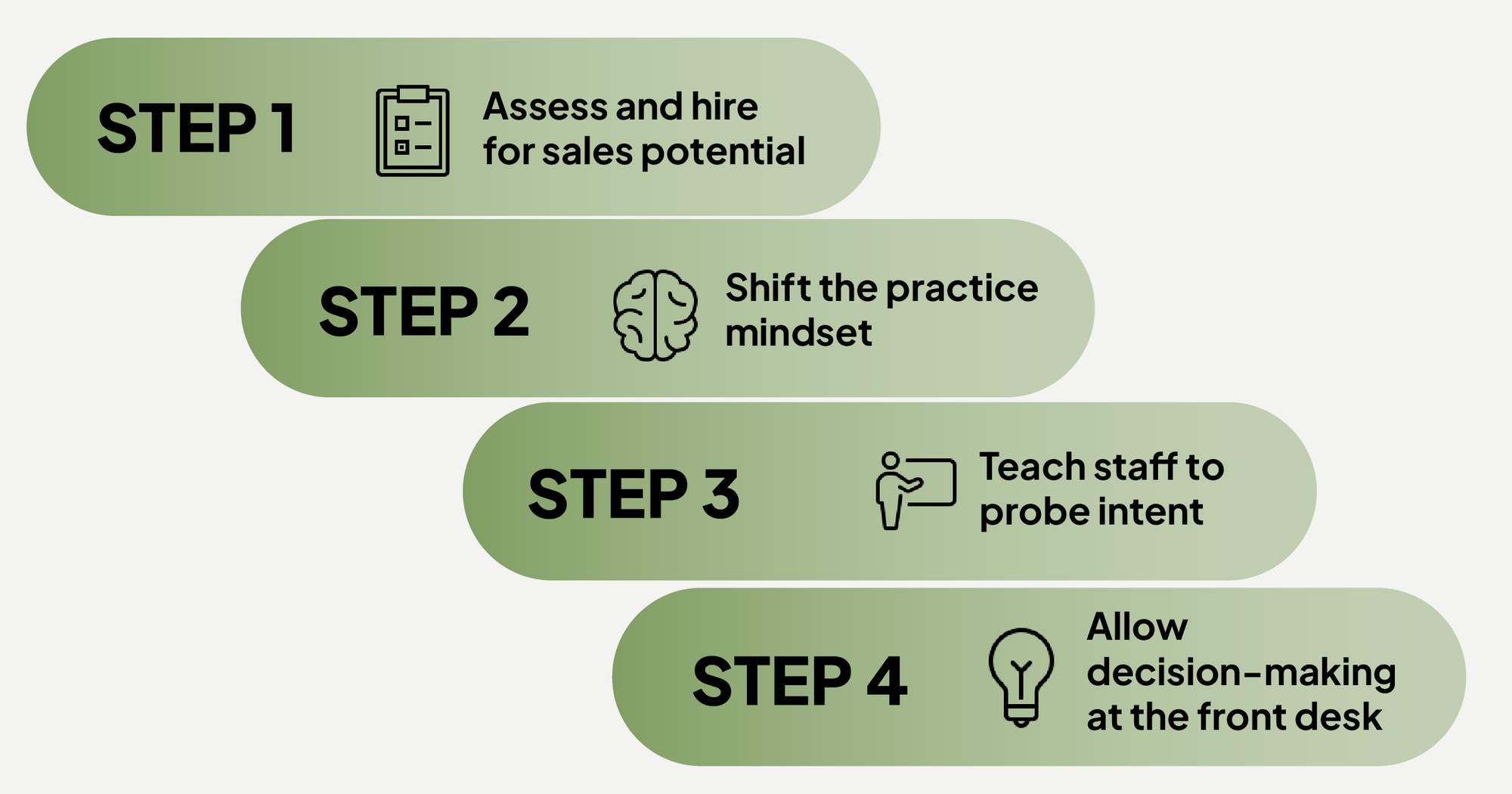Thursday, October 23, 2025
Your practice needs salespeople, not yes-people


When Jerry Durham’s physical therapy practice went out of network in the mid-2000s, he wasn’t concerned about adding more clinical services. Instead, his gut reaction was that he needed to start answering the phone differently. That instinct led him to challenge deep-rooted assumptions in the healthcare space.
Many independent rehab therapy practices treat cancellations, drop-offs, and low utilization rates as unavoidable realities.
But thirty-five years as a physical therapist, practice owner, and leader in patient engagement strategy have shown Durham that those practices are wrong. These issues are not inevitable, and practices themselves are actually a big part of what causes them — and they can also be the solution.
It all starts at the front desk.
Key Takeaways:
- Rehab therapy practices suffer from constant cancellations, drop-offs, and scheduling gaps.
- The problem lies in hiring the wrong people for front-desk roles.
- Practices should hire and train salespeople who can fill schedules with qualified patients.
You’re hiring the wrong people
When it comes to the front desk, rehab therapy practices are hiring the wrong people. And it’s costing them big time.
Durham knows this from experience, both from leading his own practice and advising others on front desk training as CEO of The Client Experience Company.
He shares that practices tend to hire for the front desk with “the face of the company” in mind. As a result, they hire customer service representatives who are caring and approach interactions as a “yes-person.” While this creates a positive atmosphere for patients on the surface, it leads to major downstream problems for practices.
Their instinct to accommodate requests means they aim to schedule anyone who calls, regardless of whether the person is actually a good fit for the practice’s services. The practice ends up with a loaded schedule (and a potentially very long waitlist). But unqualified patients eventually realize they don’t need or have the ability to commit to the services, leading to frequent cancellations, drop-offs, and incomplete treatment plans.
Practices find themselves in a situation that Durham calls the “death spiral.” They maintain waitlists of paying customers while scrambling to fill last-minute cancellation spots, leading to delayed or lost revenue. Meanwhile, providers suffer from burnout given that they see a high volume of patients who shouldn’t always be there in the first place. They needlessly spend valuable time and energy figuring that out during clinical encounters.
Salespeople > Customer service representatives
Rehab therapy practices need to change how they think about front desk roles.
Given the importance of rigorous qualification, Durham argues that practices need salespeople answering phones, not customer service representatives.
He emphasizes that these are entirely different roles, requiring entirely different types of people to fill them.
“Customer service people are not salespeople, and salespeople are not customer service people. Customer service people are the yes-people. Salespeople are the problem-solving people.”
But watching his first two sales hires fail despite stellar track records showed Durham that simply hiring salespeople isn’t enough. They also need to be trained to do the job well.
“I’ve never met a bad front desk salesperson,” says Durham. “I’ve met people who were poorly hired. I’ve met people who were hired into the wrong positions. I’ve met people who weren’t trained and onboarded properly.”
Below, we’ll share Durham’s proven process for hiring and training front desk employees who drive business growth.

Step 1: Assess and hire for sales potential
First things first, practices need to make sure that they’re hiring the right type of people for the job.
The key characteristics Durham looks for are persistence, consistency, and natural curiosity, meaning they want feedback and to be held accountable for their work.
While he says “caring” is still an essential attribute, he considers it to be a bare minimum requirement. Alone, it’s not enough to guarantee that someone will succeed at the front desk.
Searching for these attributes helps him find people who enjoy learning about others’ problems and finding solutions, rather than those who prefer predetermined administrative tasks.
Step 2: Shift the practice mindset
Once potential problem-solvers are identified, the entire practice needs to embrace a mindset shift before staff ever touch the phone.
Practices have a default mentality of “just put people on the schedule.”
But as Durham says, “Not all people who call your clinic today should be scheduled.” This goes against what practices typically teach front desk teams, so owners and managers must fully embrace this new philosophy first.
Without complete owner buy-in at this step, the rest of the process will fail.
“Not all people who call your clinic today should be scheduled.”
Step 3: Teach staff to probe intent
After establishing the new mindset, practices must give staff the tools they need to qualify patients properly.
During a year-long experiment where he personally answered every call that came into his front desk, Durham learned that prospective patients often don’t know what they’re purchasing. They say they need “physical therapy” without understanding what type, if the practice they’re calling offers it, or if they even need it at all.
That’s why Durham teaches staff members to ask about caller intent before anything else: “I’d be more than happy to talk to you about your insurance. Would you mind if I ask you a question first? Why did you call today?”
Trained staff can explore the underlying problem the caller is facing, determine whether the practice’s services actually address that issue, and, if they do, provide clear information about costs and expected outcomes.
Step 4: Allow decision-making at the front desk
There’s no point in preparing staff members to gather information without also granting them the authority to act on it.
Practices must allow staff to break with the “let me check with my manager” mentality and actually make decisions on their own, including saying “no” when appropriate. Otherwise, they can’t help patients move forward, which defeats the purpose of hiring them in the first place.
Beyond scheduling, Durham trains staff members to do more within their role. “My front desk was empowered to offer a payment plan. They could do it on the first phone call,” he explains.
Staff with decision-making authority can also determine when patients aren’t a good fit for the practice and help them find a better-suited alternative; an action Durham views as a critical responsibility. “If we can’t solve their problem, we have the obligation, I'll say damn near ethical obligation, because it’s healthcare, to move them to the right place,” he says.
Churn relief
For many practices, their front desk is the source of their biggest headaches. By following Durham’s four-step process, they can turn it into the foundation of a thriving business.
When they hire and train skilled salespeople rather than customer service representatives, they build a team that’s better equipped to qualify and educate patients from the jump.
This helps practices avoid constant churn. Patients actually show up for their appointments, complete their treatment plans, and are satisfied with the service, because they need what the practice offers and understand what’s involved. Practices don’t need to create a mile-long wait list of paying customers just to patch up scheduling gaps. Revenue is timely and predictable.
Meanwhile, practices can also prevent provider burnout. Rather than wasting clinical time managing and screening out patients who aren’t supposed to be there, providers can focus on doing their job. They can deliver care to patients who need and understand their treatment plan.
Every practice can get here. It starts with hiring the right people, giving them the tools they need to succeed, and empowering them to take their role to the next level.
